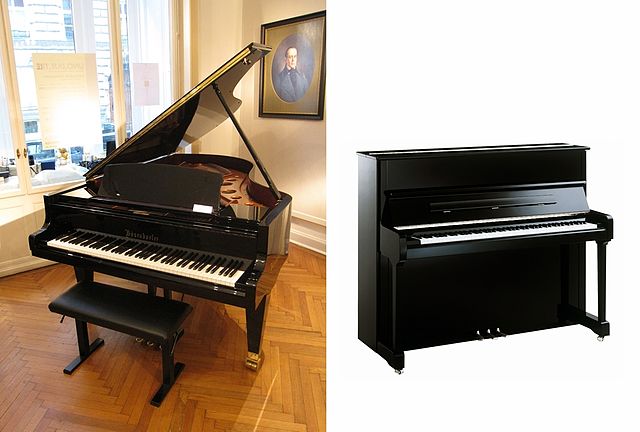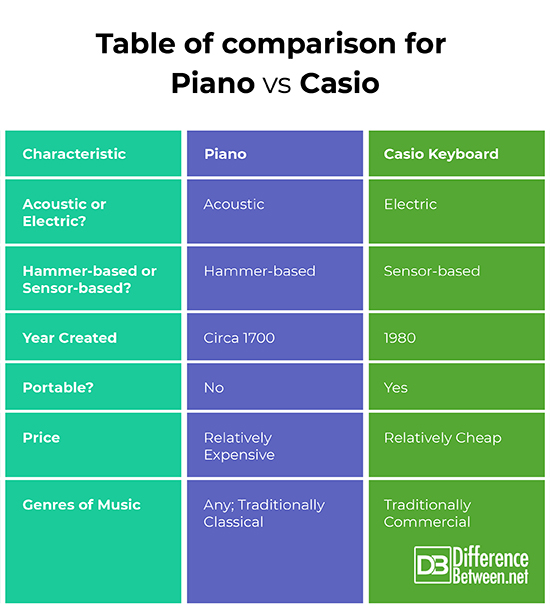Differences Between Piano and Casio
What is Piano?
A piano is a famous classical instrument that can be considered both stringed and percussive. Pianos are acoustic and use metal wires or strings to create sound. Pianos have become not only the most popular keyboard instrument but arguably the most popular instrument in existence.

What is Casio?
Casio (or CASIO) is a Japanese brand that designs electronic devices, including keyboards. Casio’s electronic keyboards are some of the world’s most well-known keyboards – they are so famous that many people call all electronic keyboards by the brand name Casio. Casio also creates digital pianos that are closer in design to traditional acoustic pianos.
Differences between a Piano and a Casio
1. Design and Sound Production of Piano and Casio
Pianos can be considered to be a combination of a stringed and percussive instrument. Inside a piano are stretched a large number of metal strings, usually between 220 and 240 strings. To make sounds on a piano, the musician presses the piano’s black and white keys. When a key is pressed down, the other end of the key rises like a lever. On this part of the key that is hidden within the piano, there is a hammer and then a dampener attached. As the end of the key lifts up, the hammer strikes the strings above the key, which then resonate and produce sound. When the key falls, the dampener – which is placed higher than the strings – drops onto the strings and silences their vibrations. The strings themselves are of different lengths – the longest strings create the lowest-pitched notes. Each key may have between 1 and 3 strings associated with it.

Casio keyboards uses sensors to regulate sound. Pressing a key activates a sensor that then produces the correct note associated with that key. On digital pianos, the keys can feel weighted like those on an acoustic piano, but they still work through sensors. Casios are essentially synthesizers with an amplifier and speakers that are designed like pianos, and therefore they can be pre-loaded with many sounds other than piano notes. These sounds may include anything from wind instruments to voices to animal noises. Electronic keyboards may also come with recording technology that allows the musician to record different parts of a song and play them together.
2. Date of Origin for Piano and Casio
The piano was not the first keyboard instrument created, but it has become the most popular by far. The modern piano was developed around 1700 C.E. by the Italian inventor Bartolomeo Cristofori. Cristofori had been hired by the famous Medici family to care for their musical instrument inventory, and he likely created the piano as a way to solve the problems of volume and dynamics present in earlier keyboard instruments. Before the piano, keyboards were either loud with no dynamics (change in volume) or dynamic but too quiet. Cristofori’s invention was dubbed the “pianoforte” (shortened to piano) because it could be both soft (piano) and loud (forte).
Casio released its first electronic keyboard, the CT-201 model, in 1980. Since then it has released nearly two dozen more models, most of which were produced in the 1980s when electronic instruments first became popular.
3. Size of Piano and Casio
Pianos are some of the largest and heaviest instruments in existence. Grand pianos can weigh 1,000 pounds, and even the smallest pianos are typically 500 pounds or more. Although pianos can be set on wheels to make them easier to move around concert halls, they are not portable instruments and most piano players depend on their venue to provide a piano for their concert.
Casios are much smaller and lighter than pianos. Because they don’t need the long strings found in acoustic pianos, they can be essentially any length. Some keyboards are so small that they only include one octave of notes, but these are usually for children. Casios are meant to be portable and can be brought to virtually any venue by their players.
4. Price for Piano and Casio
The price of a piano varies, but a good piano is usually worth tens of thousands of dollars. Grand pianos are especially expensive and may be in the range of $60,000 USD or more. Upright pianos and baby grands are typically cheaper. Pianos also need upkeep like tuning that requires hiring a professional, causing their maintenance to be costly.
Keyboards can be expensive, especially when purchasing additional equipment, but they are much cheaper than pianos. Casios are often sold at the $100 – $200 USD price-point, and other models can be even less than that.
5. Styles of Music from Piano and Casio
Pianos are perhaps the most well-known instrument in classical music. They can be readily found in orchestras and jazz bands. Pianos are also common in pop music, and there are songs with piano parts in virtually every music genre.
Electronic instruments like Casios are not traditionally found in classical music; most of the famous classical compositions were written decades or centuries before electronic keyboards were created. However, modern composers may create keyboard parts for their unique sound effects, and directors may choose to replace a piano with a keyboard if they think it will make a piece of music interesting. Keyboards are extremely common instruments in modern commercial music and many bands use a keyboard instead of a piano.
Table of comparison for Piano Vs. Casio

Summary of Piano Vs. Casio
Pianos and Casios are both popular keyboard instruments, and Casios are based off of traditional pianos. However, they are very different instruments that are used for distinct purposes.
- Pianos are acoustic string instruments that produce sound when their internal hammers strike metal strings, creating vibrations. Casio keyboards produce sound when a pressed key closes a circuit and activates a sensor.
- Pianos have existed for hundreds of years and are most known for their use in classical music, although they can be heard in nearly every genre of music. Casio keyboards, on the other hand, do not have an established place in classical music because they are digital. Instead, they are widely used in commercial (popular) music and are especially useful to DJs and producers.
- Pianos are extremely large and heavy, making them difficult to move. Most classical music venues keep a piano in storage for piano players to use during concerts. Casio keyboards are small enough that they are easily portable and can be brought to practically any venue.
- Differences Between Google Fi and T-Mobile - August 18, 2019
- Differences Between LED Bulbs and LED Fixtures - June 1, 2019
- Differences Between McAfee and Kaspersky - April 22, 2019
Search DifferenceBetween.net :
Leave a Response
References :
[0]“History of CASIO’s Musical Instrument Business.” CASIO International. “https://www.casio-intl.com/asia/en/emi/history/”
[1]Mantius Cazaubon. “Who Invented The Piano And When? ... And Why?” Piano-Keyboard-Guide. “https://www.piano-keyboard-guide.com/who-invented-the-piano.html”
[2]“How Heavy Is A Grand Piano?” Modern Piano Moving. April 5, 2017. “https://www.modernpiano.com/How-Heavy-Is-A-Grand-Piano--1-6.html”
[3]Robert Estrin. “How Many String Are On a Piano?” Living Piano. “https://livingpianos.com/pianos/how-many-strings-are-on-a-piano/”
[4]Image credit: https://upload.wikimedia.org/wikipedia/commons/thumb/c/c5/Casio_Celviano_AP620.jpg/640px-Casio_Celviano_AP620.jpg
[5]Image credit: https://upload.wikimedia.org/wikipedia/commons/thumb/c/c8/Grand_piano_and_upright_piano.jpg/640px-Grand_piano_and_upright_piano.jpg
